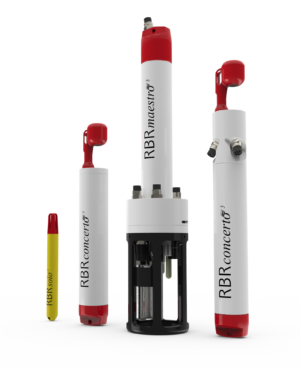November 16, 2017 – Ottawa, ON, Canada
 RBR is pleased to announce the release of Generation³, the complete renovation of the core product line, encompassing standard loggers; RBRvirtuoso, RBRduo, RBRconcerto, RBRmaestro, compact loggers; RBRsolo, RBRduet, and the standalone sensors, the RBRcoda.
RBR is pleased to announce the release of Generation³, the complete renovation of the core product line, encompassing standard loggers; RBRvirtuoso, RBRduo, RBRconcerto, RBRmaestro, compact loggers; RBRsolo, RBRduet, and the standalone sensors, the RBRcoda.
Two primary factors can sum up RBR’s Generation³ instruments; USB-C as the standardized connector on every instrument; and AA batteries – any AA battery, from alkaline to lithium – on every instrument. As an industry first, RBR’s Generation³ instruments will now feature the USB-C connector, making it easier for users to have one cable that fits all.
The use of any AA battery allows for a variety of deployment types, and in between alkaline and lithium thionyl chloride, there is a very interesting range of chemistries that RBR will support. Lithium Iron (LiFe) batteries are now widely available at a very good price with surprisingly large capacities. RBR will also now be supporting the nickel metal hydride (NiMH) rechargeable cell, that may not permit the longest deployments, but is very affordable, and has the ability to recharge several hundred times.
In keeping with consistency, to easily identify an RBR Generation³ instrument from an older generation logger, clear visual markers have been added to make differentiation easier, and this can all be summed up in one word, red.
Every new instrument will have a key mechanical component highlighted in the colour red to make it easy to identify on the shelf. For the standard logger family, the battery end cap will always be red (previously white) and for the compact logger family, the sensor tip will always be red.
In addition, the Generation³ symbol will be the number “³”. You will find that an “RBRsolo T” has now become an “RBRsolo³ T”, and an “RBRconcerto C.T.D” has become an “RBRconcerto³ C.T.D”, and so on and so forth.
Other important Generation³ updates include once again having cut instrument power consumption – so that the RBRconcerto³ C.T.D requires 30% less power than our previous instrument, making it now the lowest power oceanographic CTD on the market, and input range for power supplied through the battery end cap is now much wider – from 4V to 30V.
Profiling speeds have also been improved, by |fast8 and |fast16, respectively. Perhaps more impressively, RBR has introduced the capability for CTDs mounted on rosettes and other special applications of running at up to 32Hz: |fast32.
All standard Generation³ instruments will now come equipped with twist activation, and include the hardware for Wi-Fi in every instrument. The choice is up to the user whether they would like to enable Wi-Fi at the time of purchase, or later on as it can be easily turned on remotely from RBR headquarters.
Generation³ instrument specifics will be made available shortly on the RBR website, and the new line is expected to start shipping in December.